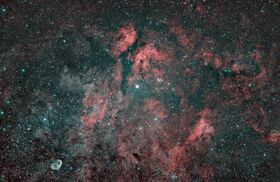Astronomy:BC Cygni
| Observation data Equinox J2000.0]] (ICRS) | |
|---|---|
| Constellation | Cygnus |
| Right ascension | 20h 21m 38.55s[1] |
| Declination | 37° 31′ 58.9″[1] |
| Apparent magnitude (V) | 9.0 - 10.8[2] |
| Characteristics | |
| Spectral type | M3.5 Ia[3] (M2 - M5[4]) |
| B−V color index | +3.13 - +3.21[4] |
| Variable type | SRc[3] |
| Astrometry | |
| Radial velocity (Rv) | −20.97[1] km/s |
| Proper motion (μ) | RA: −3.710[1] mas/yr Dec.: −6.307[1] mas/yr |
| Parallax (π) | 0.5760 ± 0.0500[1] mas |
| Distance | 1,710+40 −40[5] pc |
| Details[4] | |
| Mass | 19 M☉ |
| Radius | 1,031[6] R☉ |
| Luminosity | 204,000[5] L☉ |
| Temperature | 3,605[7] K |
| Minimum (1900) | |
| Radius | 1,553 R☉ |
| Luminosity | 145,000 L☉ |
| Temperature | 2,858 K |
| Maximum (2000) | |
| Radius | 856 R☉ |
| Luminosity | 112,000 L☉ |
| Temperature | 3,614 K |
| Other designations | |
| Database references | |
| SIMBAD | data |
BC Cygni (BC Cyg, HIP 100404, BD + 37 3903) is a red supergiant and pulsating variable star of spectral type M3.5Ia in the constellation Cygnus.
It is considered a member of the stellar Cygnus OB1 association, and within it the open cluster Berkeley 87,[8] which would place at a distance of 1,673 parsecs (5,000 ly) of the Solar System;[9] it is less than a degree north of another variable red supergiant, BI Cygni.[citation needed] According to its Gaia Data Release 3 parallax, it is at about 1,700 pc.[1]
BC Cygni was calculated to have an effective temperature of 2,858 to 3,614 K and to vary between 112,000 to 145,000 L☉. The size at its brightest and coolest has been calculated to be 1,553 R☉ compared to 856 R☉ at the hottest and faintest. It is one of largest stars known. If it were in the place of the Sun, its photosphere would engulf the orbit of Jupiter assuming the maximum radius of 1,553 R☉. With a mass of about 19 M☉, it is estimated that the stellar mass loss, as dust, as the atomic and molecular gas could not be evaluators is 3.2×10−9 M☉ per year.[10]

The brightness of BC Cyg varies from visual magnitude +9.0 and +10.8 with a period of 720 ± 40 days.[2] Between around the year 1900 and 2000 appears to have increased its average brightness of 0.5 magnitudes.[4]
See also
References
- ↑ 1.0 1.1 1.2 1.3 1.4 1.5 1.6 Vallenari, A. et al. (2022). "Gaia Data Release 3. Summary of the content and survey properties". Astronomy & Astrophysics. doi:10.1051/0004-6361/202243940 Gaia DR3 record for this source at VizieR.
- ↑ 2.0 2.1 Kiss, L. L.; Szabó, Gy. M.; Bedding, T. R. (2006). "Variability in red supergiant stars: Pulsations, long secondary periods and convection noise". Monthly Notices of the Royal Astronomical Society 372 (4): 1721–1734. doi:10.1111/j.1365-2966.2006.10973.x. Bibcode: 2006MNRAS.372.1721K.
- ↑ 3.0 3.1 Samus, N. N. et al. (2009). "VizieR Online Data Catalog: General Catalogue of Variable Stars (Samus+ 2007-2013)". VizieR On-line Data Catalog: B/GCVS. Originally Published in: 2009yCat....102025S 1. Bibcode: 2009yCat....102025S.
- ↑ 4.0 4.1 4.2 4.3 Turner, David G.; Rohanizadegan, Mina; Berdnikov, Leonid N.; Pastukhova, Elena N. (2006). "The Long-Term Behavior of the Semiregular M Supergiant Variable BC Cygni". The Publications of the Astronomical Society of the Pacific 118 (849): 1533. doi:10.1086/508905. Bibcode: 2006PASP..118.1533T.
- ↑ 5.0 5.1 Davies, Ben; Beasor, Emma R. (March 2020). "The 'red supergiant problem': the upper luminosity boundary of Type II supernova progenitors" (in en). MNRAS 493 (1): 468–476. doi:10.1093/mnras/staa174. Bibcode: 2020MNRAS.493..468D.
- ↑ Comerón, F.; Djupvik, A. A.; Schneider, N.; Pasquali, A. (October 2020). "The historical record of massive star formation in Cygnus". Astronomy & Astrophysics 2009: A62. doi:10.1051/0004-6361/202039188. Bibcode: 2020A&A...644A..62C.
- ↑ Messineo, M.; Brown, A. G. A. (2019). "A Catalog of Known Galactic K-M Stars of Class I Candidate Red Supergiants in Gaia DR2". The Astronomical Journal 158 (1): 20. doi:10.3847/1538-3881/ab1cbd. Bibcode: 2019AJ....158...20M.
- ↑ Sokal, Kimberly R.; Skinner, Stephen L.; Zhekov, Svetozar A.; Güdel, Manuel; Schmutz, Werner (2010). "Chandra Detects the Rare Oxygen-type Wolf-Rayet Star WR 142 and OB Stars in Berkeley 87". The Astrophysical Journal 715 (2): 1327. doi:10.1088/0004-637X/715/2/1327. Bibcode: 2010ApJ...715.1327S.
- ↑ de la Fuente, Diego; Román-Zúñiga, Carlos G.; Jiménez-Bailón, Elena; Alves, João; Garcia, Miriam; Venus, Sean (2021). "Clustered star formation toward Berkeley 87/ON2. I. Multiwavelength census and the population overlap problem". Astronomy and Astrophysics 650: A156. doi:10.1051/0004-6361/202040065. Bibcode: 2021A&A...650A.156D.
- ↑ Josselin, E.; Plez, B. (2007). "Atmospheric dynamics and the mass loss process in red supergiant stars". Astronomy and Astrophysics 469 (2): 671. doi:10.1051/0004-6361:20066353. Bibcode: 2007A&A...469..671J.
- ↑ "Download Data". AAVSO. https://www.aavso.org/data-download.
 |


